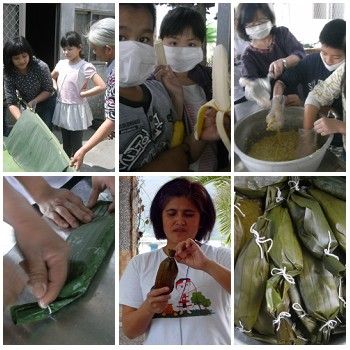|

|
Interview – The
making of banana leaf rice |
|

Interviewee: Ms. Li-lian Wang, Interviewed by:
Ting-hsuan Kao, Recorded by: Yu-hsuan Wang |
 |
1. What
ingredients do you need?
A: One of
the ingredients for banana leaf rice is glutinous
rice. It doesn’t matter whether you use short or
long grain glutinous rice. Another ingredient would
be the banana. Use really ripe bananas, ones with
bits of black spots on its skin. It will have the
sweetest taste and the best aroma. Other ingredients
were banana leaves and brown sugar or B-grade white
crystal sugar.
2. How much
rice do you need to make banana leaf rice? What kind
of rice is used? What needs to be done to the rice?
A: The
amount of rice needed depends on the number of
people being served. For example, ten people will
need 1 liter of rice. In the traditional markets one
bag of rice is equivalent to one liter. The rice
used in banana leaf rice is mostly glutinous rice.
There are two types of glutinous rice; the long
grain and the short grain. Nevertheless, you can use
both. Once you got the glutinous rice, you should
wash it then soak it in water for about 4 hours.
3. What type
of sugar is used in the making of banana rice?
A: We
usually use B-grade white crystal sugar. However,
people now are more health conscious so we have
switched to the use of brown sugar. Brown sugar is
also more aromatic. The difference between the two
types of sugar is that the B-grade white crystal
sugar takes longer to dissolve. Therefore, the sugar
does not melt into the rice until it is steamed. On
the other hand, brown sugar is finer so when it is
mixed with banana it is easily incorporated into the
mixture.
4. What do
we have to watch for when wrapping banana leaf rice
with banana leaves?
A: Since we
are making banana leaf rice, we would use banana
leaves which bring out the aroma of the banana. We
have not tried wrapping with other types of leaves.
You may try the bigger leaves. However, before you
use it you must make sure that the leaves are not
toxic. The banana leaves must be freshly picked. The
leaves must be trimmed to squares of about
20cmx20cm, and then washed and boiled in hot water
5. What are
some minor details that we have to pay attention to
while preparing banana leaf rice? Do we need extra
condiments?
A: During
the wrapping process, you have to first take care
not to break the leaf. Secondly don’t put in too
much or too little filling, because too much will
lead to the rupture of the leave and too little will
make the wrap look ugly. Therefore, the amount of
filling you put on the leaf depends on the size of
the leaf. Lastly, when you tie the leaf the string
must be tied up really tight, because the filling
may fall out during the steaming process. Since
banana is already sweet, there is no need for
further addition of condiments. Furthermore, don’t
add too much sugar or the rice would be too sweet.
6. Should the
banana leaf rice be steamed or boiled?
A: Usually
the banana leaf rice is steamed. The best way to
cook a cuisine such as the banana rice is steaming,
because it has a lot of moisture. So if you boil the
banana leaf rice it will turn into banana paste.
Therefore banana leaf rice is best steamed
7. How long
does it take to steam?
A: When you
steam banana leaf rice you have to wait until the
water is hot and boiling then you can place the
banana leaf rice into the steamer. Furthermore, each
of the banana leaf rice has to be placed with some
spaces in between because the steam will cause the
banana leaf rice to expand in size. Also the banana
leaf rice has to be stacked in different directions.
They have to be placed alternately. After the banana
leaf rice are in place you will have to cover the
lid and let them steam for 40 minutes. Make sure you
don’t steam too long, because the rice will become
very dry. However, if there is a lot of banana leaf
rice being steamed the steaming time should be
prolonged.
8. How much
water do you need to cook the rice? How much water
do you need for steaming the banana leaf rice?
A: When you
steam banana leaf rice, the water level must not
pass the bottom of the steamer; because once water
touches the banana rice you would be boiling not
steaming the rice. During the steaming process,
water will decrease over time you must add more
water but the water level should not pass the bottom
of the steamer.
9.
What does banana leaf rice taste like? Are there
salty ones? How do you eat it?
A: The
banana leaf rice is aromatic, chewy and sweet. The
Truku people rarely make savory banana leaf rice.
When you eat banana leaf rice you must untie the
string first and following its pattern unwrap the
banana leaf as you eat. Just like eating a banana.
10. Are there
any other ways of preparing banana leaf rice? Can
you eat it with other traditional aboriginal foods?
A: If you
want, you can eat it with wild grown vegetables or
vegetable soup, and if you want something creative I
would suggest that you add in some wild yam and
wolfberry. You can also try to prepare it with other
sweet vegetables or fruits. The taste would be quite
special.
11.
How long can banana leaf rice keep?
A: Banana
leaf rice after it has been steamed and cooled can
be stored in room temperature for two days and
stored in the fridge or freezer for a week.
12.
The origin of banana leaf rice?
A: In the
olden days the Truku men will go on two to three
days hunting trips. The women in fear that their men
would go hungry came up with ways that could keep
the men from their hunger. Since lunch boxes were
not invented yet the Truku women came up with the
idea of banana leaf rice. The fact that banana is
high in calories and can be kept for a long period
of time, the women came up with the idea of mixing
rice with bananas. This way the hunters will be able
to have a hearty meal.
13. Banana
leaf rice is the traditional food of what tribe?
A: Banana
rice is the traditional food of the Truku.
14. When is
banana leaf rice served? Who can’t eat it?
A: Since
it’s so convenient now, banana leaf rice is usually
served at thanksgiving worships or used to welcome
special guests. Anybody can eat it. I heard a myth
from the elders that if you make the banana leaf
rice with your heart and soul, the banana leaf rice
will have a special aroma. When women make banana
leaf rice with their heart for their husbands, the
husband will be fruitful in their hunts and harvest.
Furthermore, it will also enhance husband wife
relationship.
15. Who
taught you to make banana leaf rice?
A: This is an important question. It is a carry
forward of our culture. My mother taught me to make
banana leaf rice. When I was little I watched my
mother make banana leaf rice and I would eventually
want to learn it too.[up] |

